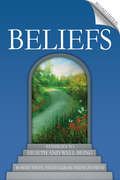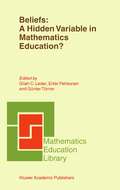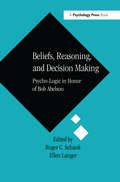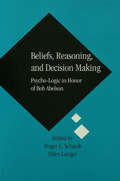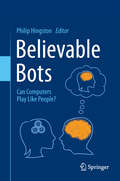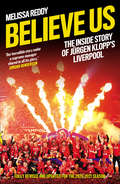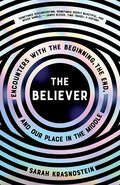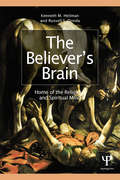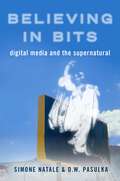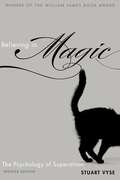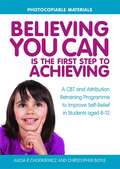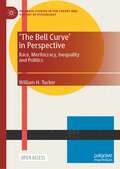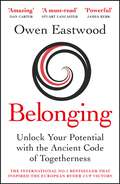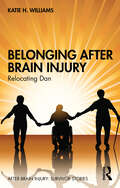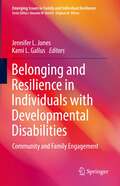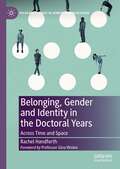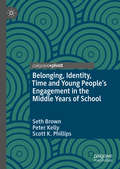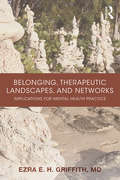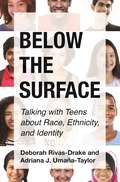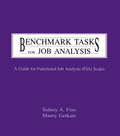- Table View
- List View
Beliefs: Pathways to health and well-being
by Robert Dilts Tim Hallbom Suzi SmithBELIEFS are the foundation of everyone's personal outcomes.This second edition of Beliefs: Pathways to Health & Well-Being includes new and updated material and offers leading edge technologies that rapidly and effectively identify and remodel limiting beliefs.It teaches you powerful processes for change and demonstrates how to identify and change beliefs using scripts from personal change work undertaken with individuals in workshops. These processes include reimprinting, conflict integration, belief/reality strategies, visualization and criteria identification.You will learn the latest methods to change beliefs which support unhealthy habits such as smoking, overeating and drug use; change the thinking processes that create phobias and unreasonable fears; retrain your immune system to eliminate allergies and deal optimally with cancer, AIDS and other diseases; and learn strategies to transform "unhealthy" beliefs into lifelong constructs of wellness.
Beliefs: A Hidden Variable In Mathematics Education? (Mathematics Education Library #31)
by Gilah C. Leder Erkki Pehkonen Günter TörnerThis book focuses on aspects of mathematical beliefs, from a variety of different perspectives. Current knowledge of the field is synthesized and existing boundaries are extended. The volume is intended for researchers in the field, as well as for mathematics educators teaching the next generation of students.
Beliefs, Reasoning, and Decision Making: Psycho-Logic in Honor of Bob Abelson
by Roger C. Schank Ellen LangerIt is not unusual for a festschrift to include offerings from several areas of study, but it is highly unusual for those areas to cross disciplinary lines. This book, in doing just that, is a testimony to Bob Abelson's impact on the disciplines of social psychology, artificial intelligence and cognitive science, and the applied areas of political psychology and decision-making. The contributors demonstrate that their association with Abelson, whether as students or colleagues, has resulted in an impressive intellectual cross-fertilization.
Beliefs, Reasoning, and Decision Making: Psycho-Logic in Honor of Bob Abelson
by Roger C. Schank Ellen LangerIt is not unusual for a festschrift to include offerings from several areas of study, but it is highly unusual for those areas to cross disciplinary lines. This book, in doing just that, is a testimony to Bob Abelson's impact on the disciplines of social psychology, artificial intelligence and cognitive science, and the applied areas of political psychology and decision-making. The contributors demonstrate that their association with Abelson, whether as students or colleagues, has resulted in an impressive intellectual cross-fertilization.
Believable Bots: Can Computers Play Like People?
by Philip HingstonWe share our modern world with bots – chatbots to converse with, roombots to clean our houses, spambots to fill our e-mail inboxes, and medibots to assist our surgeons. This book is about computer game bots, virtual companions who accompany us in virtual worlds or sharpen our fighting skills. These bots must be believable, that is human players should believe they are interacting with entities operating at a human level – bots are more fun if they behave like we do. This book shows how to create believable bots that play computer games, and it discusses the implications of making them appear human.The chapters in this book present the state of the art in research on and development of game bots, and they also look beyond the design aspects to address deep questions: Is a bot that plays like a person intelligent? Does it have emotions? Is it conscious? The topic is inherently interdisciplinary, and the work draws from research and practice in many fields, such as design, creativity, entertainment, and graphics; learning, psychology, and sociology; artificial intelligence, embodiment, agents, machine learning, robotics, human–computer interaction, and artificial life; cognition and neuroscience; and evolutionary computing. The contributing authors are among the leading researchers and developers in this field, and most of the examples and case studies involve analysis of commercial products.The book will be of value to graduate students and academic researchers in artificial intelligence, and to engineers charged with the design of entertaining games.
Believe Us: How Jürgen Klopp Transformed Liverpool Into Title Winners
by Melissa Reddy‘Our incredible story under a supreme manager shared in all its glory.’ Jordan Henderson The definitive account of Jürgen Klopp’s astonishing revival of Liverpool Football Club.
The Believer: Encounters with the Beginning, the End, and Our Place in the Middle
by Sarah Krasnostein“Deeply beautiful, and never simple.” — James Gleick, author of Time Travel: A History An unforgettable tour of the human condition that explores our universal need for belief to help us make sense of life, death, and everything in between. For Sarah Krasnostein it begins with a Mennonite choir on a subway platform, a fleeting moment of witness that sets her on a fascinating journey to discover why people need to believe in absolute truths and what happens when their beliefs crash into her own. Some of the people Krasnostein interviews believe in things many people do not: ghosts, UFOs, the literal creation of the universe in six days. Some believe in things most people would like to: dying with dignity and autonomy; facing up to our transgressions with truthfulness; living with integrity and compassion. By turns devastating and uplifting, and captured in snapshot-vivid detail, these six profiles — a death doula, a geologist who believes the world is six thousand years old, a lecturer in neurobiology who spends his weekends ghost hunting, the fiancé of a disappeared pilot and UFO enthusiasts, a woman incarcerated for killing her husband after suffering years of domestic violence, and Mennonite families in New York — will leave you convinced that the most ordinary-seeming people are often the most remarkable and that deep and abiding commonalities can be found within the greatest differences. Vivid, unconventional, entertaining, and full of wonder, The Believer interweaves these stories with compassion and empathy, culminating in an unforgettable tour of the human condition that cuts to the core of who we are as people, and what we’re doing on this earth.
The Believer's Brain: Home of the Religious and Spiritual Mind
by Kenneth M. Heilman Russell S. DondaAbout 90% of people have faith in a supreme being, but our yearning for the divine, and whatever it promises, involves a large divergence in mental states and behaviors. Some adhere to doctrine, supplication, and fastidious religious practices; others have a strong sense they are part of something greater and more universal. However, all religious and spiritual paths are mediated by complex brain networks. When different areas of the brain are stimulated, a person can have a variety of experiences, but there is no specific ‘God spot’ where stimulation enhances religiosity or spirituality. Functional brain imaging shows that there are specific areas of the brain that ‘light up’ when subjects perform certain religious activities, but imaging only provides anatomic correlations, not functional explanations. The Believer's Brain takes a step beyond these singular methodologies, providing converging evidence from a variety study methods of how humans’ brain networks mediate different aspects of religious and spiritual beliefs, feelings, actions, and experiences. Although the book reveals how our brain is the home to the religious and spiritual mind, understanding this gift will not diminish our spirituality or our love or our belief in a supreme being, but will increase appreciation of the apparatus that mediates these mental states.
The Believer's Brain: Home of the Religious and Spiritual Mind
by Kenneth M. Heilman Russell S. DondaAbout 90% of people have faith in a supreme being, but our yearning for the divine, and whatever it promises, involves a large divergence in mental states and behaviors. Some adhere to doctrine, supplication, and fastidious religious practices; others have a strong sense they are part of something greater and more universal. However, all religious and spiritual paths are mediated by complex brain networks. When different areas of the brain are stimulated, a person can have a variety of experiences, but there is no specific ‘God spot’ where stimulation enhances religiosity or spirituality. Functional brain imaging shows that there are specific areas of the brain that ‘light up’ when subjects perform certain religious activities, but imaging only provides anatomic correlations, not functional explanations. The Believer's Brain takes a step beyond these singular methodologies, providing converging evidence from a variety study methods of how humans’ brain networks mediate different aspects of religious and spiritual beliefs, feelings, actions, and experiences. Although the book reveals how our brain is the home to the religious and spiritual mind, understanding this gift will not diminish our spirituality or our love or our belief in a supreme being, but will increase appreciation of the apparatus that mediates these mental states.
Believing in Bits: Digital Media and the Supernatural
Believing in Bits advances the idea that religious beliefs and practices have become inextricably linked to the functioning of digital media. How did we come to associate things such as mindreading and spirit communications with the functioning of digital technologies? How does the internetâs capacity to facilitate the proliferation of beliefs blur the boundaries between what is considered fiction and fact? Addressing these and similar questions, the volume challenges and redefines established understandings of digital media and culture by employing the notions of belief, religion, and the supernatural.
BELIEVING IN BITS C: Digital Media and the Supernatural
by Simone Natale, D. W. PasulkaBelieving in Bits advances the idea that religious beliefs and practices have become inextricably linked to the functioning of digital media. How did we come to associate things such as mindreading and spirit communications with the functioning of digital technologies? How does the internetâs capacity to facilitate the proliferation of beliefs blur the boundaries between what is considered fiction and fact? Addressing these and similar questions, the volume challenges and redefines established understandings of digital media and culture by employing the notions of belief, religion, and the supernatural.
Believing in Magic: The Psychology of Superstition - Updated Edition
by Stuart A. VyseWhile we live in a technologically and scientifically advanced age, superstition is as widespread as ever. Not limited to just athletes and actors, superstitious beliefs are common among people of all occupations, educational backgrounds, and income levels. In this fully updated edition of Believing in Magic, renowned superstition expert Stuart Vyse investigates our tendency towards these irrational beliefs. Superstitions, he writes, are the natural result of several psychological processes, including our human sensitivity to coincidence, a penchant for developing rituals to fill time (to battle nerves, impatience, or both), our efforts to cope with uncertainty, the need for control, and more. In a new Introduction, Vyse discusses important developments and the latest research on jinxes, paranormal beliefs, and luck. He also distinguishes superstition from paranormal and religious beliefs and identifies the potential benefits of superstition for believers. He examines the research to demonstrate how we can better understand complex human behavior. Although superstition is a normal part of our culture, Vyse argues that we must provide alternative methods of coping with life's uncertainties by teaching decision analysis, promoting science education, and challenging ourselves to critically evaluate the sources of our beliefs.
Believing You Can is the First Step to Achieving: A CBT and Attribution Retraining Programme to Improve Self-Belief in Students aged 8-12 (PDF)
by Christopher Boyle Alicia ChodkiewiczBelieving You Can is the First Step to Achieving is a fun and engaging programme for students in the upper primary years that teaches the difference between helpful and unhelpful thinking, increases self-belief and in doing so increases motivation to learn. Do you ever hear students using phrases such as "I'm not smart enough to do this?" or "I know I am going to fail?" Combining techniques from Cognitive Behavioural Therapy and Attribution Retraining, this programme teaches students the link between thoughts, feelings and actions, how to challenge negative thinking and how to celebrate success. The structured programme includes a photocopiable student workbook, role play games and other activity ideas, and all of the instruction and materials needed to easily implement the programme in any school. This will be an ideal resource for educational professionals looking to increase school attainment, support students who are underachieving, and encourage healthy and happy student development.
'The Bell Curve' in Perspective: Race, Meritocracy, Inequality and Politics (Palgrave Studies in the Theory and History of Psychology)
by William H. TuckerThis open access book examines the implications of The Bell Curve for the social, economic, and political developments of the early 21st century. Following a review of the reception of The Bell Curve and its place in the campaign to end affirmative action, Professor Tucker analyses Herrnstein’s concept of the “meritocracy” in relation to earlier 20th century eugenics and the dramatic increase in economic inequality over the past 30 years. Tucker demonstrates how, contrary to The Bell Curve’s predictions, the reallocation of these huge sums was neither rational nor beneficial for society. The book moves on to situate The Bell Curve within contemporary politics and shows how it can be seen to have played a role in the 2016 US election. This compelling analysis will appeal to scholars and those with an interest in the history of scientific racism, the history of psychology and the sociology of knowledge and science.This is an open access book.
Belonging: The Ancient Code of Togetherness
by Owen EastwoodWhakapapa. You belong here.Whakapapa is a Maori idea which embodies our universal human need to belong. It represents a powerful spiritual belief - that each of us is part of an unbroken and unbreakable chain of people who share a sacred identity and culture.Owen Eastwood places this concept at the core of his methods to maximise a team's performance. In this book he reveals, for the first time, the ethos that has made him one of the most in-demand Performance Coaches in the world.In Belonging, Owen weaves together insights from homo sapiens' evolutionary story and ancestral wisdom. He shines a light on where these powerful ideas are applied around our world in high-performing settings encompassing sport, business, the arts and military.Aspects of Owen's unique approach include: finding your identity story; defining a shared purpose; visioning future success; sharing ownership with others; understanding the 'silent dance' that plays out in groups; setting the conditions to unleash talent; and converting our diversity into a competitive advantage.
Belonging After Brain Injury: Relocating Dan (After Brain Injury: Survivor Stories)
by Katie H. WilliamsBelonging After Brain Injury: Relocating Dan explores the life of the author’s brother who has dealt with the effects of a severe traumatic brain injury (TBI) for over four decades. It recounts the institutional, psychological, and social labyrinths he and his family have navigated following the TBI he sustained at the age of eighteen. This insightful volume offers a holistic account of the impact of TBI on the survivor and his family. It reveals the difficulties a TBI survivor has had to endure and provides practical information about physical, psychological, and psychosocial symptoms and their consequences. Dan’s story offers new perspectives and strategies that will help alleviate seemingly intractable problems and highlights the central importance of forming connections with others in order to lead a fuller life. The author’s account of her own journey, learning to help care for and advocate for Dan, offers an invaluable guide for TBI survivors and those who care for and support them. Belonging After Brain Injury: Relocating Dan will be of interest to TBI survivors and their families. Its rich insights will be essential reading for medical and mental health professionals, as well those involved in the care and rehabilitation of TBI survivors and families.
Belonging After Brain Injury: Relocating Dan (After Brain Injury: Survivor Stories)
by Katie H. WilliamsBelonging After Brain Injury: Relocating Dan explores the life of the author’s brother who has dealt with the effects of a severe traumatic brain injury (TBI) for over four decades. It recounts the institutional, psychological, and social labyrinths he and his family have navigated following the TBI he sustained at the age of eighteen. This insightful volume offers a holistic account of the impact of TBI on the survivor and his family. It reveals the difficulties a TBI survivor has had to endure and provides practical information about physical, psychological, and psychosocial symptoms and their consequences. Dan’s story offers new perspectives and strategies that will help alleviate seemingly intractable problems and highlights the central importance of forming connections with others in order to lead a fuller life. The author’s account of her own journey, learning to help care for and advocate for Dan, offers an invaluable guide for TBI survivors and those who care for and support them. Belonging After Brain Injury: Relocating Dan will be of interest to TBI survivors and their families. Its rich insights will be essential reading for medical and mental health professionals, as well those involved in the care and rehabilitation of TBI survivors and families.
Belonging and Resilience in Individuals with Developmental Disabilities: Community and Family Engagement (Emerging Issues in Family and Individual Resilience)
by Jennifer L. Jones Kami L. GallusThis book examines belonging as a key protective factor for enhancing resilience for individuals with intellectual and developmental disabilities and their families. It focuses on understanding intellectual and developmental disabilities and resilience from systemic and social-ecological perspectives, emphasizing the roles of professionals, families, and communities in combating long-standing segregation and health disparities experienced by individuals and families. The volume explores the dimensions of belonging across diverse professional fields using a person-centered approach that acknowledges the significant lifelong role of family members and emphasizes reflective practice for professionals. Chapters present research and innovative strategies to facilitate belonging when working alongside individuals and families.Key areas of coverage include: Family-professional partnerships in working with individuals with intellectual and developmental disabilities across lifespan and community contexts. Spirituality, mental health, and identity in persons with intellectual and developmental disabilities. Research ethics and design in working with individuals with intellectual and developmental disabilities. The diverse needs, desires, and preferences of individuals with intellectual and developmental disabilities. The importance of individualized planning and approaches in fostering belonging for individuals with intellectual and developmental disabilities. Belonging and Resilience in Individuals with Developmental Disabilities is a valuable resource for researchers, professors, and graduate students as well as clinicians, therapists, and related professionals in developmental psychology, family studies, public health, and social work as well as related disciplines, including education policy and politics, behavioral health, and psychiatry.
Belonging, Gender and Identity in the Doctoral Years: Across Time and Space (Palgrave Studies in Gender and Education)
by Rachel HandforthThis book uses belonging as a lens through which to understand women students’ experiences of studying for a doctorate, exploring the impact of academic cultures on career aspirations. Drawing on discourses of neoliberalism and academic identities, it makes a valuable contribution to ongoing discussions of gender inequality in the academy. Based on data gathered from women doctoral students in the UK, this book offers a contemporary, research-informed understanding of the doctorate as an inherently gendered experience, which has implications for individuals, academic institutions, and for the future of the academic sector. The book will be of interest to academics working in the area of doctoral education, doctoral supervisors and those involved in doctoral student support, including researcher developers and individuals working in graduate schools, as well as doctoral students themselves.
Belonging, Identity, Time and Young People’s Engagement in the Middle Years of School
by Seth Brown Peter Kelly Scott K. PhillipsThis book explores the complex ways in which belonging, identity and time are entangled in shaping young people engagement with the middle years of school. The authors argue that these ‘entanglements’ need to be understood in ways that move beyond a focus on why individual young people engage with the middle years. Instead, there should be a focus on the socio-ecologies of particular places, and the ways in which these ecologies shape the possibilities of young people engaging productively in the middle years. Drawing on extensive qualitative data from an outer-urban metropolitan context, this book will appeal to scholars of sociology, education and policy studies.
Belonging, Therapeutic Landscapes, and Networks: Implications for Mental Health Practice
by Ezra GriffithWhy are certain places perceived to be therapeutic, to make people feel better about life, about themselves, and about their bodies? Could there be environmental, individual, societal, and attachment factors that come together in the healing process in both traditional and non-traditional landscapes? This observation is particularly important and has implications for the understanding of both healing and disruption in the lives of individuals. In Belonging, Therapeutic Landscapes, and Networks, Dr. Griffith examines factors that influence the intersection of health and place, one’s sense of belonging, and the constructing of therapeutic spaces that minimize psychosocial disruption in our daily lives.
Belonging, Therapeutic Landscapes, and Networks: Implications for Mental Health Practice
by Ezra GriffithWhy are certain places perceived to be therapeutic, to make people feel better about life, about themselves, and about their bodies? Could there be environmental, individual, societal, and attachment factors that come together in the healing process in both traditional and non-traditional landscapes? This observation is particularly important and has implications for the understanding of both healing and disruption in the lives of individuals. In Belonging, Therapeutic Landscapes, and Networks, Dr. Griffith examines factors that influence the intersection of health and place, one’s sense of belonging, and the constructing of therapeutic spaces that minimize psychosocial disruption in our daily lives.
Below the Surface: Talking with Teens about Race, Ethnicity, and Identity
by Deborah Rivas-Drake Adriana Umaña-TaylorA guide to the latest research on how young people can develop positive ethnic-racial identities and strong interracial relationsToday’s young people are growing up in an increasingly ethnically and racially diverse society. How do we help them navigate this world productively, given some of the seemingly intractable conflicts we constantly hear about? In Below the Surface, Deborah Rivas-Drake and Adriana Umaña-Taylor explore the latest research in ethnic and racial identity and interracial relations among diverse youth in the United States. Drawing from multiple disciplines, including developmental psychology, social psychology, education, and sociology, the authors demonstrate that young people can have a strong ethnic-racial identity and still view other groups positively, and that in fact, possessing a solid ethnic-racial identity makes it possible to have a more genuine understanding of other groups.During adolescence, teens reexamine, redefine, and consolidate their ethnic-racial identities in the context of family, schools, peers, communities, and the media. The authors explore each of these areas and the ways that ideas of ethnicity and race are implicitly and explicitly taught. They provide convincing evidence that all young people—ethnic majority and minority alike—benefit from engaging in meaningful dialogues about race and ethnicity with caring adults in their lives, which help them build a better perspective about their identity and a foundation for engaging in positive relationships with those who are different from them.Timely and accessible, Below the Surface is an ideal resource for parents, teachers, educators, school administrators, clergy, and all who want to help young people navigate their growth and development successfully.
Below the Surface: Talking with Teens about Race, Ethnicity, and Identity
by Deborah Rivas-Drake Adriana Umaña-TaylorA guide to the latest research on how young people can develop positive ethnic-racial identities and strong interracial relationsToday’s young people are growing up in an increasingly ethnically and racially diverse society. How do we help them navigate this world productively, given some of the seemingly intractable conflicts we constantly hear about? In Below the Surface, Deborah Rivas-Drake and Adriana Umaña-Taylor explore the latest research in ethnic and racial identity and interracial relations among diverse youth in the United States. Drawing from multiple disciplines, including developmental psychology, social psychology, education, and sociology, the authors demonstrate that young people can have a strong ethnic-racial identity and still view other groups positively, and that in fact, possessing a solid ethnic-racial identity makes it possible to have a more genuine understanding of other groups.During adolescence, teens reexamine, redefine, and consolidate their ethnic-racial identities in the context of family, schools, peers, communities, and the media. The authors explore each of these areas and the ways that ideas of ethnicity and race are implicitly and explicitly taught. They provide convincing evidence that all young people—ethnic majority and minority alike—benefit from engaging in meaningful dialogues about race and ethnicity with caring adults in their lives, which help them build a better perspective about their identity and a foundation for engaging in positive relationships with those who are different from them.Timely and accessible, Below the Surface is an ideal resource for parents, teachers, educators, school administrators, clergy, and all who want to help young people navigate their growth and development successfully.
Benchmark Tasks for Job Analysis: A Guide for Functional Job Analysis (fja) Scales (Applied Psychology Series)
by Sidney A. Fine Maury GetkateHuman resource practitioners are repeatedly faced with the challenge of effectively using language to clearly describe the work performed on a job. Functional Job Analysis--an internationally recognized and respected job analysis method --has been meeting this challenge for more than forty years. In this book, the authors show how human resource practitioners can use structured task statements and comprehensive rating scales to gain the perspective needed to map the domain of any job. In response to the demands of human resource practitioners, the book focuses on the seven scales used in Functional Job Analysis. More than 450 structured tasks were used to illustrate the breadth and scope of all the levels of these scales. These tasks can be used effectively as benchmarks to chart the work requirements of virtually any job. Personnel practitioners will find insights into the challenges of job analysis, as well as the tools needed to make job analysis more comprehensive, useful, and effective for human resources. Representing the most comprehensive information to date on the use of Functional Job Analysis scales for rating job tasks, this book: *addresses the problems of using language to clearly describe how work is performed on the job; *describes the relation between the need to carefully control the language of job analysis and the structure inherent in the Functional Job Analysis Worker Function scales--a conceptual link showing the reader that the key to understanding work is in the vocabulary used to describe work; *contains the most comprehensive treatment of the way to write clear and comprehensive task statements available in the job analysis literature; and *contains a sample task bank for the job of Functional Job Analysts--aiding the reader in understanding how a complete Functional Job Analysis should look.
